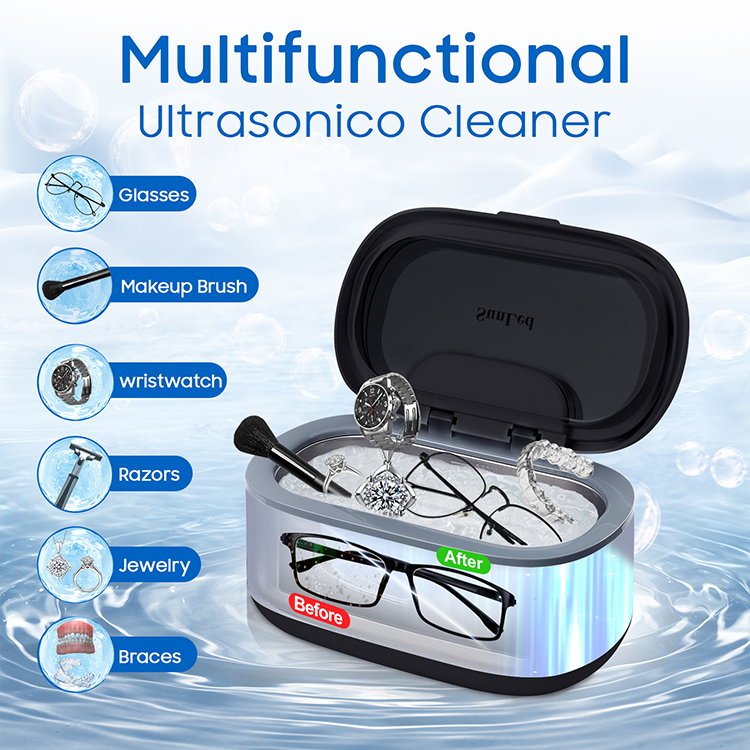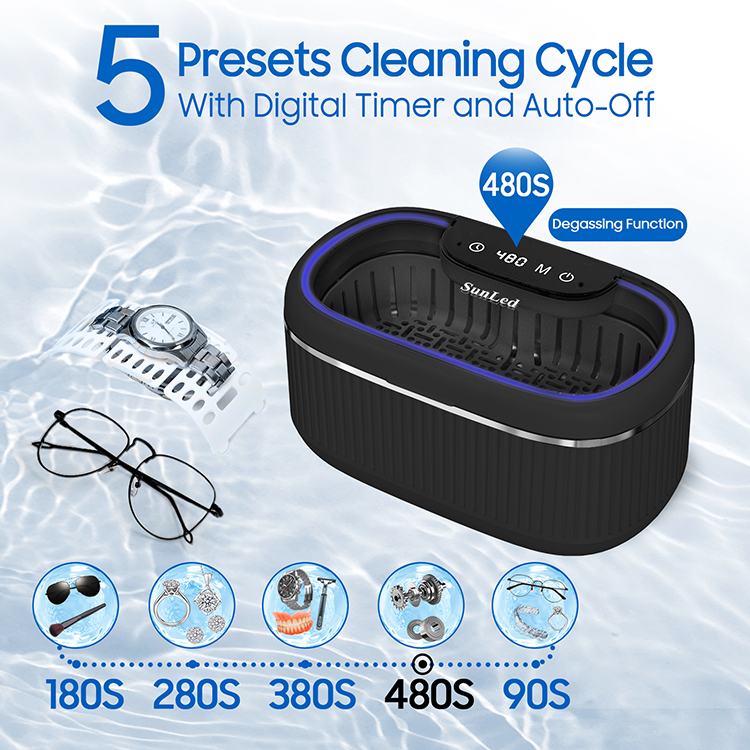With ultrasonic cleaners becoming increasingly popular in households, more people are using them to clean eyeglasses, jewelry, watch bands, and other small everyday items. Compared with hand washing, an ultrasonic cleaner provides a fast and convenient way to remove dirt and grime. However, a common question often arises:
Can you safely clean sunglasses with an ultrasonic cleaner?
The short answer is yes—but it depends on the material and coating of your sunglasses. Understanding how ultrasonic cleaning works and using it correctly can help you achieve excellent results without damaging your lenses.
How Does an Ultrasonic Cleaner Work?
An ultrasonic cleaner works through a process called cavitation. When the machine operates, high-frequency sound waves create countless microscopic bubbles in the cleaning liquid. These bubbles rapidly form and collapse, releasing tiny bursts of energy that dislodge dirt, oil, and dust from the surface of objects.
This process allows the cleaner to reach deep into small gaps and tight areas—such as hinges, screws, and frame corners—without the need for harsh scrubbing or strong chemicals. That’s why ultrasonic cleaning is ideal for delicate and intricate items like eyeglasses, rings, and precision tools.
Why Some Sunglasses Are Not Suitable for Ultrasonic Cleaning
Although ultrasonic cleaning is a gentle and effective method, it’s not suitable for all sunglasses. The safety mainly depends on the material and surface treatment of the lenses.
Many sunglasses feature special coatings, such as UV protection layers, polarized films, or reflective mirror coatings. These coatings are typically attached through chemical or physical processes. During ultrasonic cleaning, the high-frequency vibrations and localized pressure changes from cavitation can stress these thin layers. If the cleaning power is too strong or the duration too long, it may cause edge peeling, micro-cracks, or uneven gloss.
Some lightweight resin lenses are also sensitive to heat. The slight temperature rise and vibration generated during ultrasonic cleaning might cause microfractures or minor warping on the lens surface.
Additionally, using hot water or cleaning solutions containing alcohol or alkaline substances can intensify the cavitation effect, accelerating the aging or discoloration of coatings. Therefore, plain water or a mild neutral detergent is the safest choice.
Which Sunglasses Can Be Cleaned and Which Should Be Avoided
Generally, sunglasses with metal frames and non-coated glass lenses are safe to clean with an ultrasonic cleaner.
Models with plastic frames and regular resin lenses can also be cleaned, but users should choose a low-power setting and keep the cleaning time short.
However, sunglasses with polarized, mirrored, or anti-reflective coatings should not be cleaned using ultrasonic waves, as these films are easily damaged by vibration and temperature changes.
If you are unsure about your sunglasses’ materials, check the product details or consult the manufacturer. When in doubt, it’s safer to hand-clean with warm water and a soft cloth instead of risking potential coating damage.
How to Safely Clean Sunglasses with an Ultrasonic Cleaner
If your sunglasses are suitable for ultrasonic cleaning, follow these steps to ensure a safe process:
Use plain water or mild cleaning solution. Avoid alcohol, strong acids, or alkaline detergents.
Choose a low-power mode. Gentle cleaning is enough to remove dust and oil.
Limit the cleaning time. One to two minutes is ideal; never exceed three minutes.
Dry gently. After cleaning, use a soft microfiber cloth to wipe or let the sunglasses air dry naturally.
By following these precautions, you can effectively clean your sunglasses without causing damage to the lenses or frames.
Sunled Ultrasonic Cleaner: Designed for Safe and Smart Cleaning
Among household cleaning devices, the Sunled Ultrasonic Cleaner stands out for its combination of safety, intelligence, and versatility.
It features three adjustable power levels (3 Power for option), allowing users to match cleaning strength with the material type. For delicate sunglasses, the lowest power mode ensures thorough yet gentle cleaning.
The cleaner also offers five timer options (90S / 180S / 280S / 380S / 480S), giving users full control over cleaning duration—from quick rinsing to deep cleaning cycles. Its 304 stainless steel inner tank ensures durability and resistance to corrosion, while the low-noise design provides a quiet and comfortable user experience.
Beyond sunglasses, the Sunled Ultrasonic Cleaner is suitable for a wide range of household items, including eyeglasses, jewelry, watches, razor heads, and even tableware. Whether for daily use or periodic maintenance, it delivers a professional-level cleaning effect in the comfort of your home.
For sunglasses made with non-coated glass or resin lenses, using the Sunled Ultrasonic Cleaner in a low-power, short-duration mode can effectively remove dust, fingerprints, and oils—restoring a crystal-clear look without risking damage.
Conclusion
Ultrasonic cleaners can indeed help restore the shine and cleanliness of your sunglasses, but they are not suitable for every type of lens. Coated or polarized sunglasses should be handled carefully, as improper cleaning may cause irreversible damage.
When used correctly—at the right power level, temperature, and duration—an ultrasonic cleaner becomes a reliable and efficient household tool for maintaining precision items.
The Sunled Ultrasonic Cleaner, with its multiple power and timer options, provides users with a safe and customizable cleaning experience. It helps you keep your sunglasses and other delicate belongings spotless, smartly combining technology and convenience in one compact design.
Post time: Nov-06-2025


